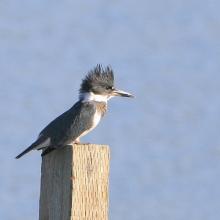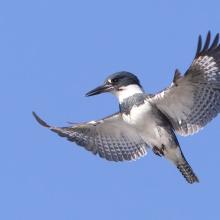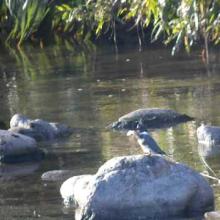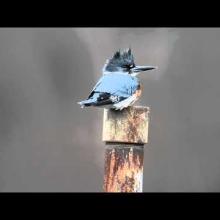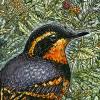

Join BirdNote tomorrow, November 30th!
Illustrator David Sibley and actor H. Jon Benjamin will face off in the bird illustration battle of the century during BirdNote's Year-end Celebration and Auction!
In the 1990s, train engineers in Japan built trains able to travel nearly 170 miles per hour. The problem was that when the trains exited a tunnel, the air in front of their bullet-shaped noses expanded rapidly, creating a loud “tunnel boom.” The chief engineer, a birder, looked to the shape of a kingfisher’s bill to design long, narrow train noses that parted the air. The trains became both quieter and more efficient.
BirdNote®
Biomimicry - Japanese Trains Mimic Kingfisher
Written by Chris Peterson
This is BirdNote.
In the 1990s, train engineers in Japan built incredibly fast trains, reaching speeds of nearly 170 miles per hour — but they had a problem.
[Sound of a train running at high speed]
When a train with a rounded, bullet-shaped nose entered a tunnel, the train would compress the air. So then, when the train reached the end of the tunnel, the air expanded so rapidly that it created a “tunnel boom”...
[Sound of “tunnel boom”]
...that bothered wildlife and people living near the tunnels.
[Sound of “tunnel boom”]
But the chief engineer for the West Japan Railway Company was a birder. And he’d seen kingfishers dive into the water with hardly a splash. Kingfisher beaks are long and narrow, with a smooth transition between the base of the beak and the face. This reduces the amount of drag when the kingfisher enters the water. So the engineer and his team imitated that beak and created a shape that, when fitted on the front of the engine, would part the air rather than compress it.
[Sound of a train running quietly at high speed]
This subtle change made the trains quieter, faster, and more energy efficient. So trains in Japan now operate at beak performance.
[Common Kingfisher calls]
Solving problems by modeling after nature is known as “biomimicry.” Sometimes, the best solution is right there in front of us, if only we’re willing to look for it.
[Common Kingfisher calls]
For BirdNote, I’m Ariana Remmel.
###
Senior Producer: John Kessler
Production Manager: Allison Wilson
Producer: Mark Bramhill
Associate Producer: Ellen Blackstone
Digital Producer: Conor Gearin
Bird sounds provided by The Macaulay Library of Natural Sounds at the Cornell Lab of Ornithology, Ithaca, New York. Common Kingfisher ML 56433 recorded by S. Connop.
BirdNote’s theme was composed and played by Nancy Rumbel and John Kessler.
© 2022 BirdNote March 2013/2018/ January 2022 Narrator: Ariana Remmel
ID# biomimicry-01-2013-03-21 biomimicry-01c
Reference: https://royalsocietypublishing.org/doi/10.1098/rsif.2019.0125
https://www.bbc.com/news/av/science-environment-47673287




